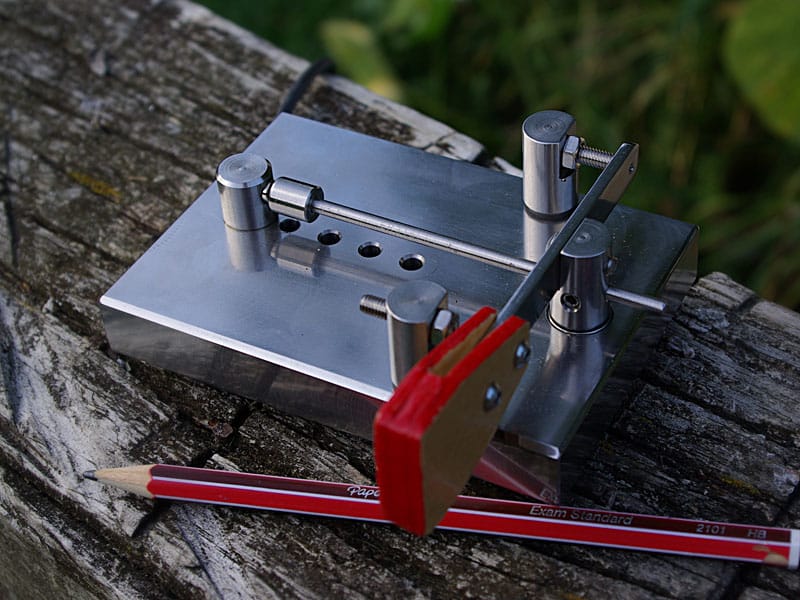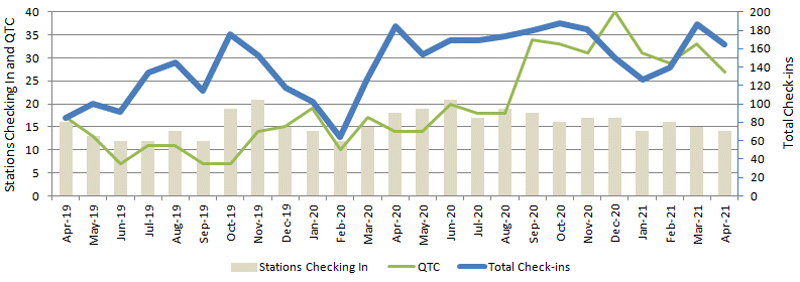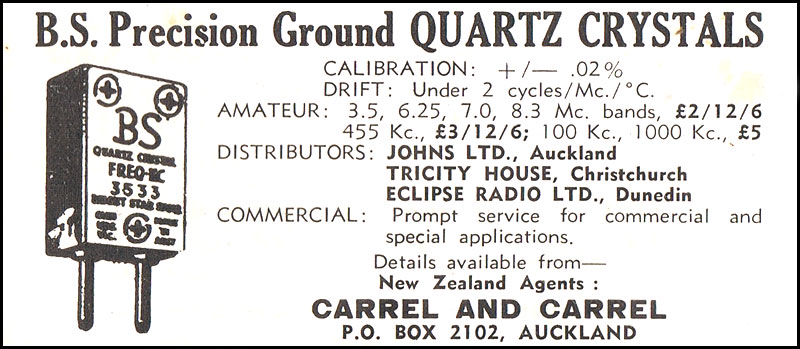This is a fortnightly newsletter about the New Zealand Net. If you would like to be notified by email when a new edition is published, please contact ZL1NZ.
Browse our Newsletter Archive and List of Net Tips.
Featured key

This keyer was built a few months ago by Gerard ZL2GVA, following discussions with Stephen ZL1ANY who was interested in getting a single-lever paddle. The key uses a ball bearing pivot and magnetic return, with the magnets being in the post at the left and at the left end of the rod.
“I had never used a single-lever,” says Gerard, “and after trialling this one I can see the appeal of them. You get a bit more swing than you do with iambic keying, and I’ve seen references that you are less prone to make errors at higher speeds (I already make enough at lower speeds!).
“Stephen had a number of references that we looked at, ranging from Eastern Europe style (very utilitarian, but effective, some innovative mechanisms too), to highly polished versions.
“A single lever in this configuration is a bit different, in that the arm has to return to the same centre spot, without an end-stop if ball bearings are used. Springs or magnets may be used, but we settled on the style of a KN4YB design for the base, combined with a magnet as we saw at PA3BVW, rather than a blade spring.”
How does Gerard get that shiny red finish on the paddles? Nail polish from the $2 shop!
* If you have an interesting key for this feature, please send me a nice clear photo and a few words describing it.
Quick notes
The Sangster Shield, New Zealand’s longest-running amateur radio contest, is this Saturday and Sunday evening from 2000 to 2300 hours. It’s CW on 80m with a power limit of 5W output.

ZL2KE is installing a new shack. We look forward to photos of the end result.
The Samuel F Morse Amateur Radio Club is running its annual Bug Roundup, a ragchewing event for bug operators, from 0000 Sat 22 May to 2359 Sun 23 May (UTC).
In NZ Net News Nr50, I wrote about how to handle a book of messages (a system to avoid repetition when we have several messages to the same address, for example, or several identical messages to multiple addresses). In early May, I sent a book of ten messages to be delivered by ZL4FZ to ten newly licensed radio amateurs at his club. The messages were relayed to ZL4FZ by ZL2GD. In this recording, you’ll hear the first leg of their journey, from ZL1NZ to ZL2GD during the NZ Net.
Net numbers

NR48 R ZL1NZ 37/34 AUCKLAND 0900Z 3MAY21 = NZ NET = APR QNI ZL1AJY 9 ZL1ANY 19 ZL1BWG 18 ZL1NZ 22 ZL2GD 17 ZL2GVA 19 ZL2KE 8 ZL2LN 4 ZL2WT 4 ZL4CU 3 ZL4KX 17 ZL4LDY 1 VK3DRQ 17 VK4PN 7 TOTAL 165 QTC 27 = ZL1NZ
Photo flashback

ZL1AP with his RTTY station on the cover of Break-In, August 1980
Getting the word out
We’ve recently had several mentions of NZ Net in various channels.
- Debby and Annalise at NZART kindly included a promo for NZ Net in the Infoline newsletter #429. If you haven’t already subscribed to Infoline (it’s a fortnightly email) you can do so my contacting NZART. I found that my previous subscription, from back in the days when Don ZL3DMC published Infoline, had lapsed in the transition to the current system.
 Newly licensed amateur Tim ZL3PIE posted on Reddit that he had received a congratulatory radiogram via NZ Net. This was the message referenced above, which had been relayed via ZL2GD and delivered by ZL4FZ. Tim posted a photo of it, and there were many positive comments from other Redditers too. Thanks Tim!
Newly licensed amateur Tim ZL3PIE posted on Reddit that he had received a congratulatory radiogram via NZ Net. This was the message referenced above, which had been relayed via ZL2GD and delivered by ZL4FZ. Tim posted a photo of it, and there were many positive comments from other Redditers too. Thanks Tim!- Selwyn ZL2BJO mentioned NZ Net in his Old Timers Club column in a recent edition of Break-In magazine.
- Roger G3LDI included some information about the Net in the latest newsletter of the Norfolk Amateur Radio Club. The club also has a CW net.
Audio challenge: Whose speech is this?
The following is part of the text of a speech by a famous New Zealander. Your challenge is to copy the short excerpt, then tell me who was speaking (please reply via radiogram or email).
[AUDIO NO LONGER AVAILABLE]
Answer to the previous challenge: In the storm warning from Wellington Radio ZLW, winds were forecast to reach 35-45 knots “in a belt 40 miles wide centred on line from Stephens Island to near 39 South 171 East.”
I received correct answers from VK5EEE, ZL1ANY, ZL1BBW, ZL2GVA and ZL3TK. Apologies if I overlooked anyone, my filing system isn’t the best!
Video: Rogaland Radio
In NZ Net News NR42, our Photo Flashback was a lovely view of the receiving station at Rogaland Radio. I commented on some cool antenna selector displays. Now here’s a video (how’s your Norwegian?) showing the station in operation.
Preservation: Musick Memorial Radio Station

Part of the museum room at Musick Point
One of Auckland’s little-known treasures is the Musick Memorial Radio Station, the receiving site for Auckland Radio ZLD, which closed in 1993.
Although the museum is a fairly small area on the ground floor of the radio station, visitors will find the whole building fascinating. Musick Memorial Radio Station is managed by the Musick Point Radio Group (NZART Branch 86) and is open to visitors by appointment only. Details are on the MPRG website.
Net tip: QNY
 Ever since we began the NZ Net, more than two years ago, any traffic listed on the Net has been cleared (handled) on the net frequency. The idea behind this was that many NZ amateurs had not experienced traffic handling, so it created an opportunity for all stations to listen and learn.
Ever since we began the NZ Net, more than two years ago, any traffic listed on the Net has been cleared (handled) on the net frequency. The idea behind this was that many NZ amateurs had not experienced traffic handling, so it created an opportunity for all stations to listen and learn.
But I think we’ve now reached the point where we can, and should, clear at least some of our traffic off-frequency (which is typically how full-time traffic nets do things). It will help keep the Net moving efficiently.
Clearing traffic off-frequency is particularly appropriate if we have a pair of stations checking in fairly early with traffic to exchange.
For example:
Suppose ZL1ANY checks in with “QRU” during the first few minutes of the net. Within a few minutes, ZL2WT checks in with “QTC1 ZL1ANY”.
NCS knows that these two stations generally copy each other well (i.e. they will not need anyone else to relay) so as soon as ZL2WT has checked in, NCS may send:
ZL2WT QNY U2 ZL1ANY
which means “ZL2WT go up 2kHz and send your traffic to ZL1ANY”.
ZL2WT and ZL1ANY then each acknowledge the instruction from NCS with a quick “R” and off they go. If NCS does not hear two “R”s, NCS will ask each station to confirm.
(As an aside, on a busy traffic net overseas, it would not be unusual to have half a dozen pairs of stations off frequency at one time. NCS might assign them “U2”, “D2”, “U4”, “D4”, and so on, and then have to keep track of where each station was, and which frequencies were available or in use. And that was all being done before there were computers, bandscopes and online SDRs with waterfall displays!)
When directing stations to QNY, NCS will name the sending station first (in this case ZL2WT). After both stations have moved off frequency, the sending station will find a clear spot at least 2kHz above the Net, and call the receiving station.
As soon as they have cleared their traffic both stations return to the Net and check in again. This is REALLY important, because NCS needs to know where each station is at all times during the Net, in order to assign additional traffic, or to make sure everyone is on frequency for a QNC (message to all stations).
When they are back on net frequency, each returning station checks in again by sending their sine. NCS will acknowledge, and each station can simply send “QNI”. Or, they might say that they couldn’t find each other, in which case NCS will decide whether to dispatch them again or have them clear their traffic on the net frequency.
Sending stations off frequency helps keep the net brief and efficient. But, NCS will use their discretion. If it’s late in the net, it does not make sense to send people off frequency, and then have to keep the net open just so they can return and the Net can then be closed.
In summary, if you are checking in during the early part of the Net, don’t be surprised if NCS sends you off frequency to clear traffic. And please be sure to come back after you’ve finished!
If you have any questions about QNY, please send me a radiogram or email.
Advertising archive
I thought this advertisement was interesting because it mentions amateur bands at 6.25 and 8.3 Mc/s. I had never heard of those bands. Do any of our readers know anything about them?

Source: NZART Questions & Answers, c1950
Suggestions?
If you have suggestions on how to make the NZ Net better, or things you’d like to see covered in these updates, please contact ZL1NZ. You might even like to write something for the newsletter.
Thanks for reading, and I hope to see you soon on the NZ Net!
—
Neil Sanderson ZL1NZ, Net Manager
New Zealand Net (NZ NET)
3535.0 kHz at 9pm NZT Mon-Fri




